REPTILES AND AMPHIBIANS
Throughout the territory, 55 species of reptiles and 34 of amphibians have been reported, such as the Green Sea Turtle (Chelonia mydas) and the Green Poisoned Dart Frog (Dendrobates auratus).
Throughout the territory, 55 species of reptiles and 34 of amphibians have been reported, such as the Green Sea Turtle (Chelonia mydas) and the Green Poisoned Dart Frog (Dendrobates auratus).
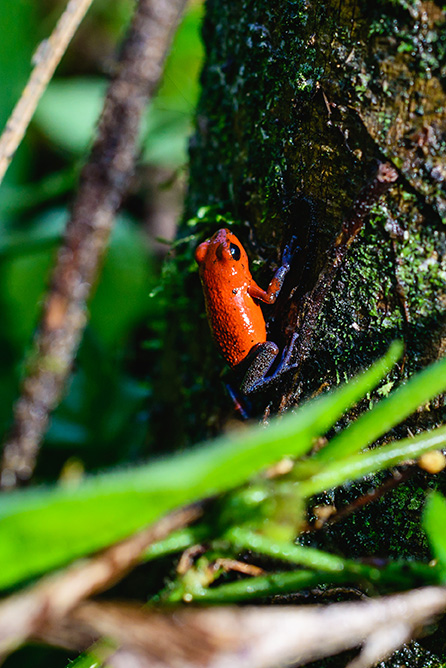 Name: Strawberry poison dart frog.
Name: Strawberry poison dart frog.
Scientific name: Oophaga pumilio.
Natural history: They live on the floor of the moderately open understory, as well as in the vegetation of the tropical rainforest, alsoin abandoned cocoa and banana plantations. They feed mainly on ants and termites, since these preys are very small, frogs must invest a lot of time and energy in foraging.
They also eat mosquitoes, grasshoppers, small snails. Males defend singing territories through a combination of physical combat and vocalizations. It has been shown that competition between adult males for territories is linked to the availability of bromeliads (for location of tadpoles).
Other research supports the thesis that these frogs select their territory based in part on the availability of ants. They lay their eggs in moist places on the ground, in litter, or under logs, then move the tadpoles into the water on the back of an adult.
Courtship and mating of this species occurs once the male attracts the female with his song, goes forward looking for an appropriate site for oviposition and she follows him. When she lags behind, he stops and calls out to her softly, waiting for her to catch up.
After 7 days, the female collects a single tadpole and takes it to the water, deposited in a bromeliad, for its development. The mean duration of transport from a tadpole to a bromeliad was determined to be 3 hours. The male also carries tadpoles. The rearing of a tadpole can last 22-23 days.
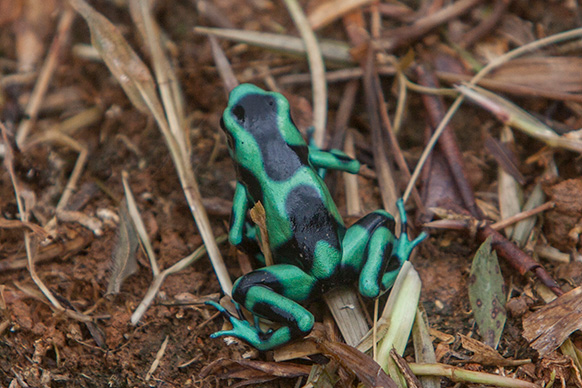
Name: Green poison dart frog.
Scientific name: Dendrobates auratus.
Natural history: It lives on the floor of humid forests and has also been found in epiphytic bromeliads at heights of 3 – 25 m off the ground. When the tadpoles are developed, they climb on the back of the male who takes them to aquatic habitats such as containers formed by fallen fruits and leaves, bromeliads and holes in the branches.
It feeds on ants and other small insects. This species has toxins similar to Oophaga pumilio that are a very powerful neurotoxic poison, causing muscle contraction, and other alkaloids that serve as a defense against predators.
To complete their life cycle, these frogs are dependent on water. The males have a complicated ritual to attract a mate, first they fight each other to establish territories for mating, later they attract a female with songs.
Over the course of two weeks, the male visits the eggs from time to time to rotate them and remove any microorganisms that have settled in them. Males can mate with up to six females and care for all offspring simultaneously, thereby increasing the reproductive success of males.
The indigenous people of the Amazon used the poison of these frogs and spread the darts and arrows of these compounds to hunt animals. The effect of a poison dart is paralysis of the central nervous system and cardiac arrest. Due to their striking and beautiful colors, these living frogs are highly appreciated as pets.
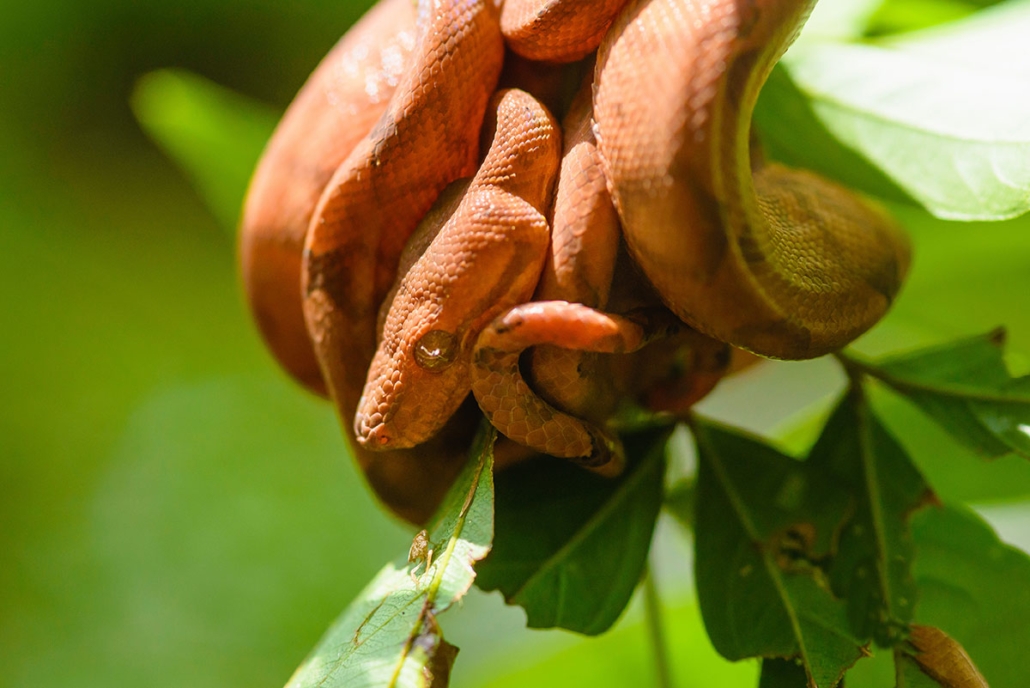
Scientific name:
Boa constrictor.
Name:
Boa.
• Status: Threatened species. Trade is restricted.
• Closed period: Partially banned from April 1st to August 31st.
Natural history: It is a non-poisonous snake; it is both arboreal and terrestrial and has a wide range of habitats. It is a slow and deliberate snake in its movements. Their temperament is highly variable, there are individuals who are very difficult to induce to bite and others who attack indiscriminately, at any opportunity.
Tame and calm specimens can be a valuable tool to use in environmental education. Boas consume a wide variety of prey such as rats, mice, lizards, birds, and mammals, including monkeys. Because the bones of the pelvic girdle are externally visible, in certain rural areas it is associated with evil spirit forms.
Likewise, it is considered a snake capable of giving birth to poisonous snakes of all kinds; This is due to the polychromatism(many colors) characteristic of newborns and its resemblance to poisonous snakes such as pitvipers or Terciopelo, which is why it is indiscriminately killed.
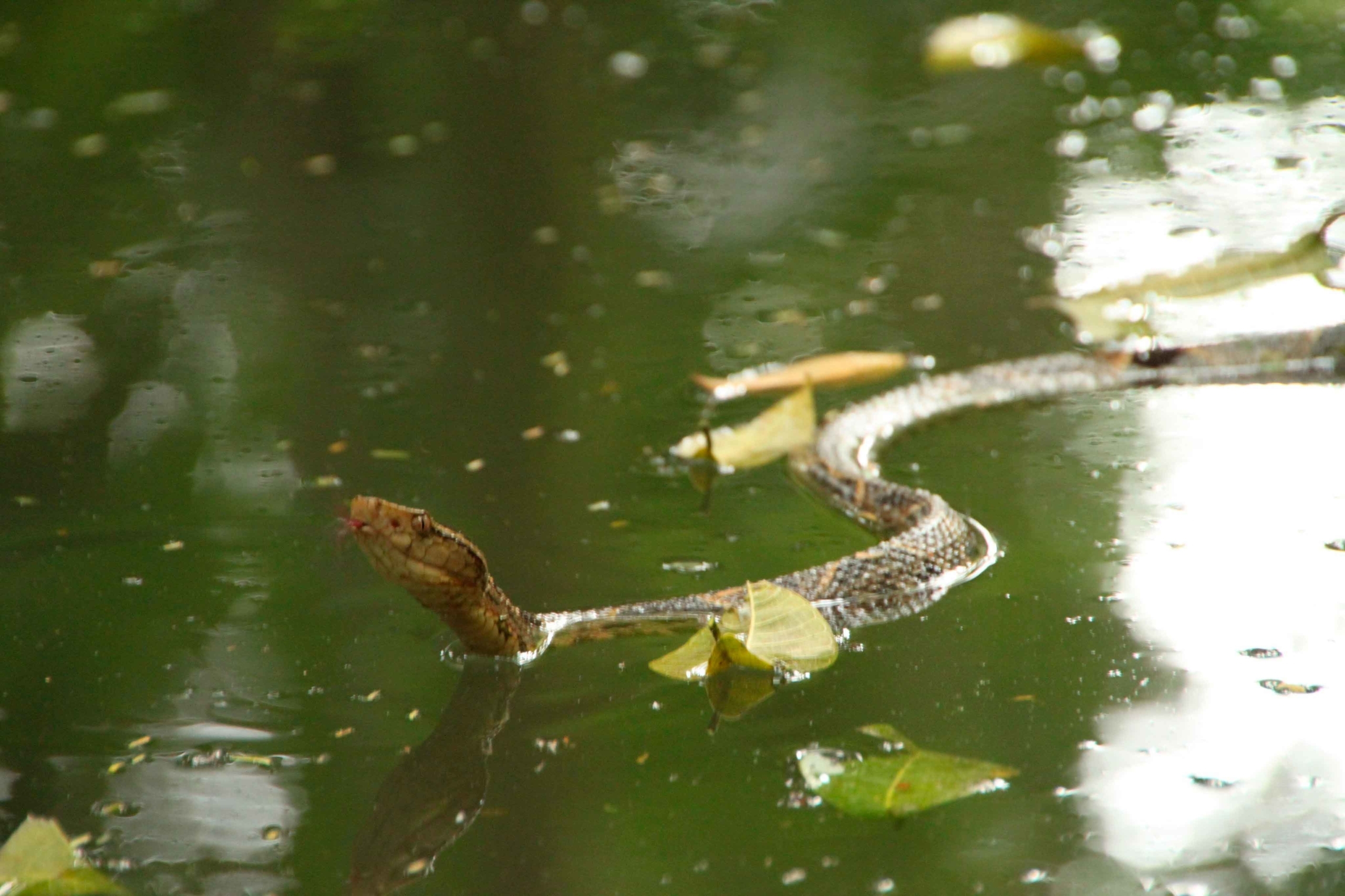
Name: Terciopelo
Scientific name: Bothrops asper.
Natural history: Terciopelo is a species of poisonous snake found in Central America and northern South America. Found in a wide range of lowland habitats, often near human settlements. It is a large and nervous species.
Snakes of both sexes are born the same size, but at 7 to 12 months of age, females begin to grow faster than males.In general, adults are between 140-180 cm. Males never reach more than 195 cm in length, while females have an average size of 185 cm, with a confirmed maximum length of 250 cm.
Females have thick bodies and the largest can weigh up to 6 kg, although heavier specimens have been reported.
The head of females is two to three times larger than that of males in proportion to their size and their fangs are also proportionally larger (typically 2.5 cm).
In general, males stop eating for a time after the start of the reproductive cycle, while females stop eating within a few months of pregnancy. Mating occurs at different times of the year and in different areas. Gestation normally lasts between 180 and 240 days, and it is a viviparous species and doesn’t lay eggs like many other snake species.
The average litter is about 30 young. This species is mainly nocturnal, hiding in leaf litter or among tree roots during the day. Juveniles are often semi-arboreal and even adults are sometimes found in shrubs and low trees.
When disturbed they can move very quickly and generally choose to flee from danger but are able to suddenly reverse direction to defend themselves aggressivley. When cornered and fully alert, adult specimens should be considered very dangerous.
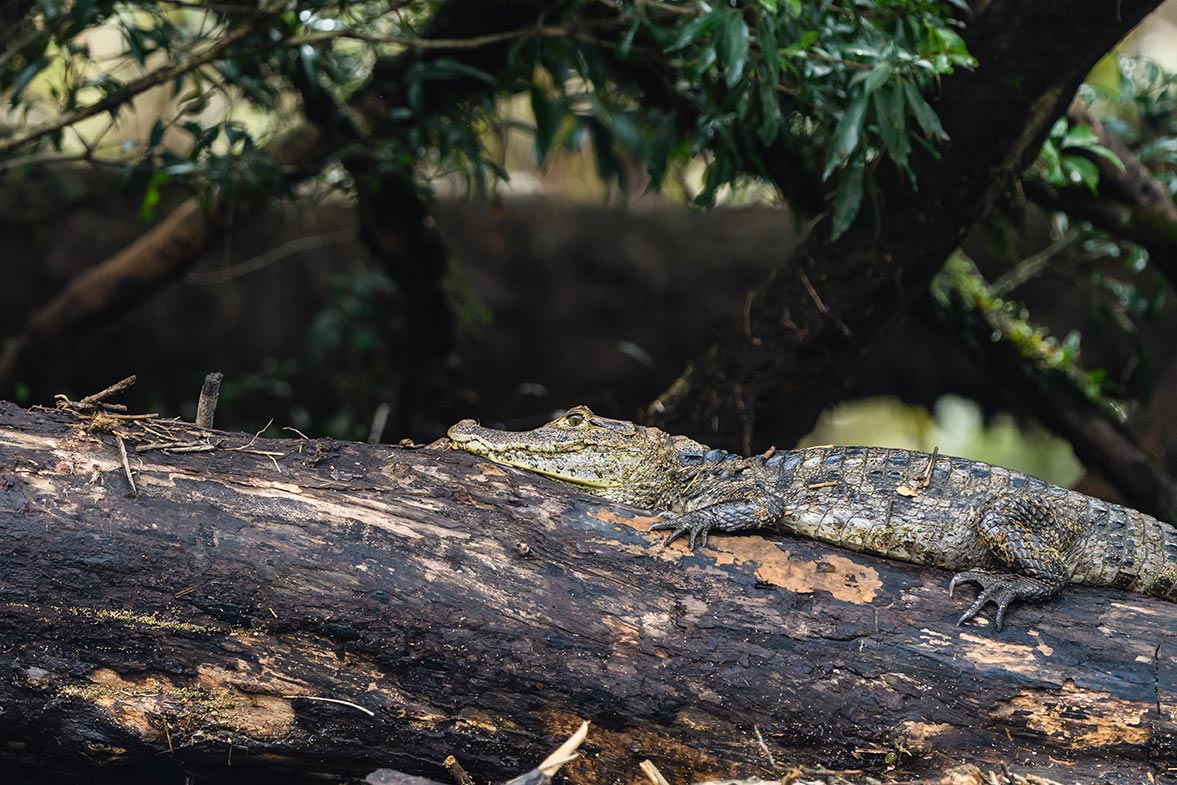
Name: Spectacled caiman.
Scientific name: Caiman crocodilus.
Natural history: Like all crocodiles, it is an aquatic reptile in the shape of a large lizard, reaching more than 1 m in length. They use their four limbs to walk and their tail compressed laterally to propel themselves into the water; It is found in rivers and other bodies of water up to 350 m high. It is an oviparous (egg laying) species.
They build nests made up of mounds of different materials that include leaves, branches, and mud. Births have been reported throughout the year. Incubation lasts approximately 75 days. Juvenile individuals produce vocalizations that stimulate adult parents to open the nest and allow it to emerge.
This vocalization is maintained for a period of up to 4 months and encourages adults to return, which is associated with defense behaviors. It feeds on aquatic birds, fish, and other vertebrates that approach or live in its waters. It is indiscriminately hunted to use the skin to make items such as purses, shoes, belts, among others.
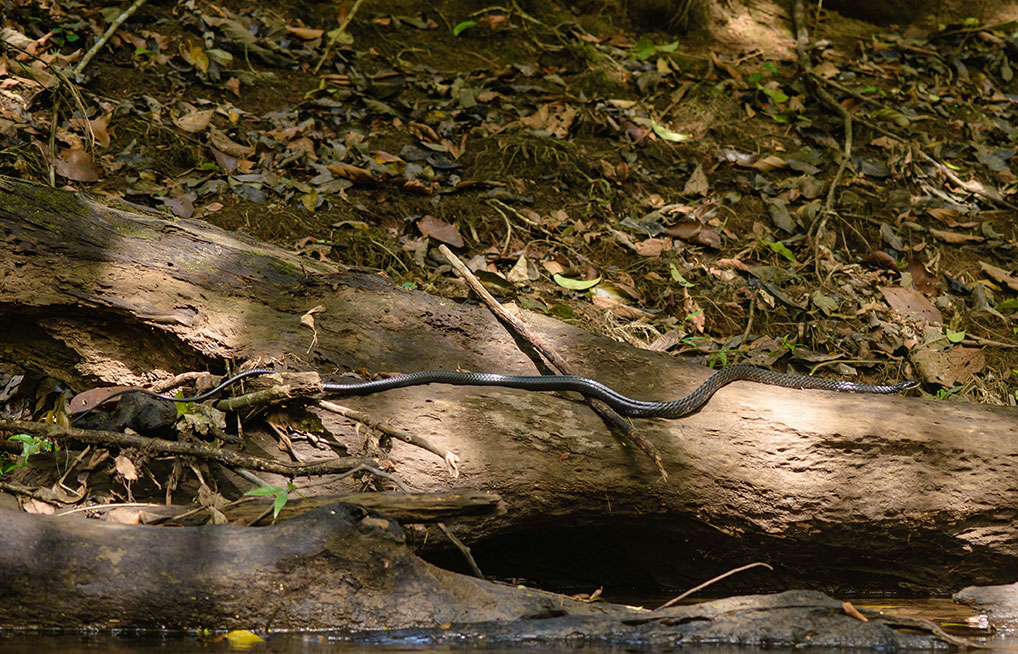
Name: Bird snake.
Scientific name: Phrynonax poecilonotus.
Natural history: The Bird snake (Phrynonax poecilonotus) is a species of snake that belongs to the Colubridae family, the only one of its kind. It is native to Mexico, Central America (Belize, Guatemala, Honduras, El Salvador, Nicaragua, Costa Rica, Panama) and South America (Colombia, Venezuela, Brazil, Ecuador, Peru, and Bolivia).
Its altitudinal range oscillates between 0 and 1200 meters above sea level. It lives in humid lowland forest and savanna. It also lives in grasslands where it is usually found in small trees. It is a diurnal, terrestrial and semi-arboreal species.
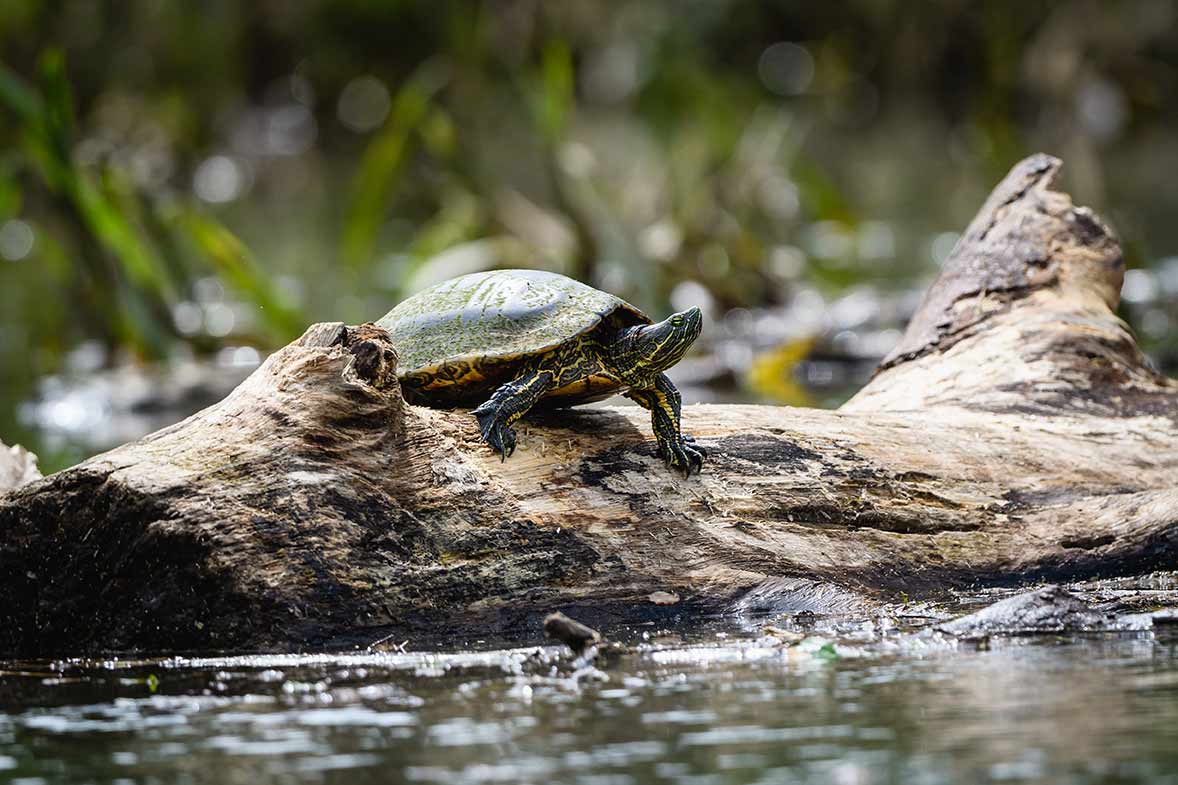
Name: Black wood turtle.
Scientific name: Rhiniclemmys funerea.
Natural history: The black wood turtle is a species of turtle of the Geoemydidae family native to Central America. It is found from Honduras to Panama.
Geoemydids (Geoemydidae) are a family of turtles made up of 69 species distributed throughout the world.

Name: Green iguana.
Scientific name: Iguana iguana.
Natural history: The green iguana, also known as the common iguana or hen de palo (Iguana iguana), a species of the Iguanidae family. It is a large arboreal lizard. It measures up to 2 m in length from head to tail. Males reach between 30 and 40 cm in snout-cloaca length, females about 10 cm; Their tails are extremely long and somewhat flattened laterally.
It weighs more than 15 kg. It belongs to the largest and most elaborately designed group of the New World lizards, to which most species belong. A narrow head, rounded snout in dorsal view and truncated in lateral view; large eyes with vertically elliptical pupils; robust and powerful arms with fingers equipped with very strong nails; The gular fold is conspicuously large in adult males and with triangular scales on the edges giving a serrated appearance.
At the base of the head begins a row of wide and elongated scales that extends in the mid-dorsal part on the body and tail. On the sides of the head, it presents an elongated circular shield. Commonly with elongated spiny bones called tubercles on the sides of the neck. They change color depending on age.
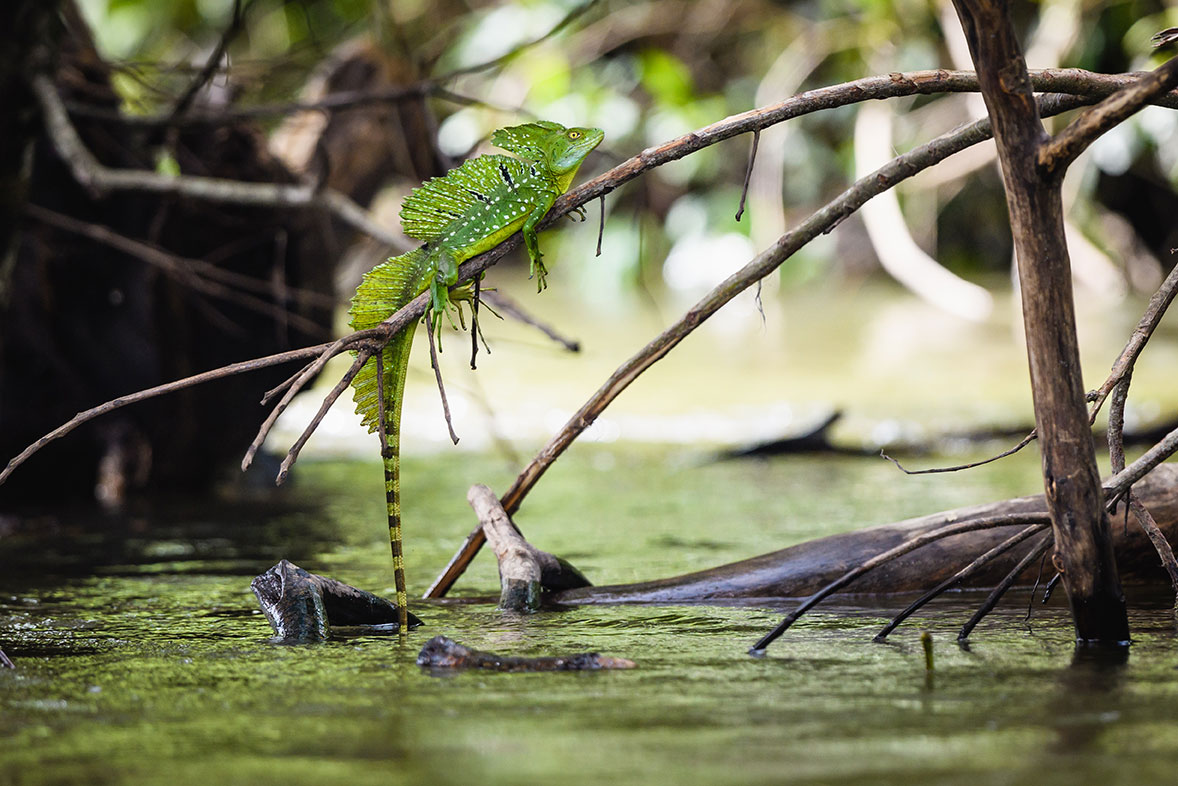
Name: Plumed basilisk.
Nombre científico: Basiliscus plumifrons.
Natural history: Plumed basilisks are omnivores and feed on insects, small mammals such as rodents, and even some smaller species of lizards. Its diet also includes fruits and flowers. Among its most frequent predators are birds of prey, opossums and snakes.
The females of this species lay between 5 and 15 eggs at a time. They deposit these eggs in warm places, damp sand or dirt. They take between eight and ten weeks to incubate, after which the young specimen is born as a totally independent lizard.
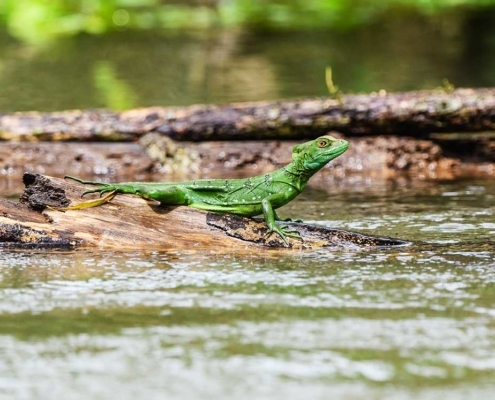
Female basilisk.
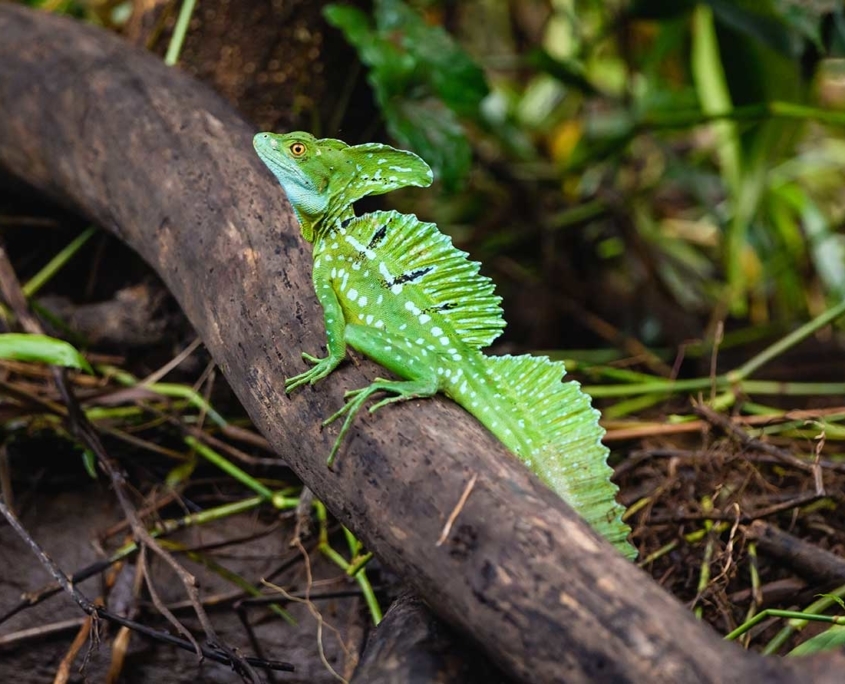
Male basilisk
Like other basilisks, this lizard has the ability to run on water for short distances, using special membranes on its legs that increase its support surface on the water. Notwithstanding this, it is also a remarkable swimmer, being able to be submerged for periods of time greater than 30 minutes.
The average size of these animals is around 90-100 cm, with the males being larger, reaching up to 120 cm. Males in their adulthood develop showy ridges along the head and back, however the females show much less obvious and sometimes even unnoticeable ridges.
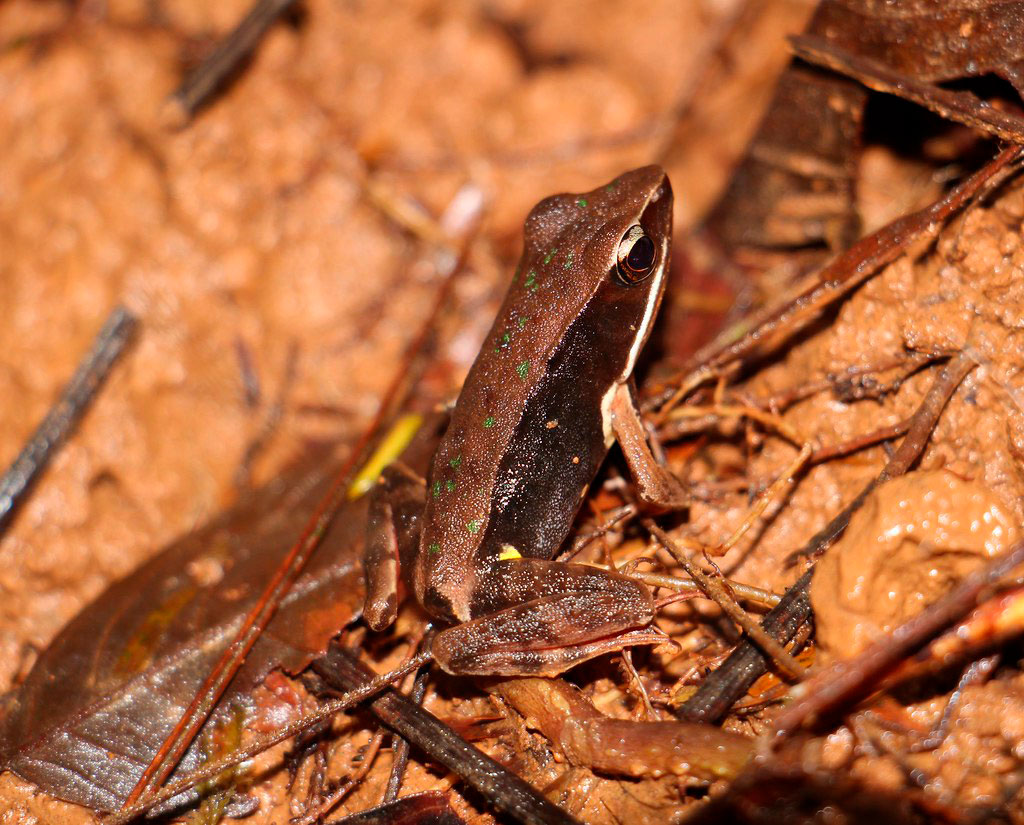
Name: Warszewitsch’s frog.
Scientific name: Lithobates warszewitschii.
Natural history: The Warszewitsch’s Frog is a species of frog in the Ranidae family. This species lives from sea level to 1740 m of altitude in Honduras, Nicaragua, Costa Rica and Panama. They live in a very humid environment on the forest floor. This species measures up to 48 mm for males and 63 mm for females.
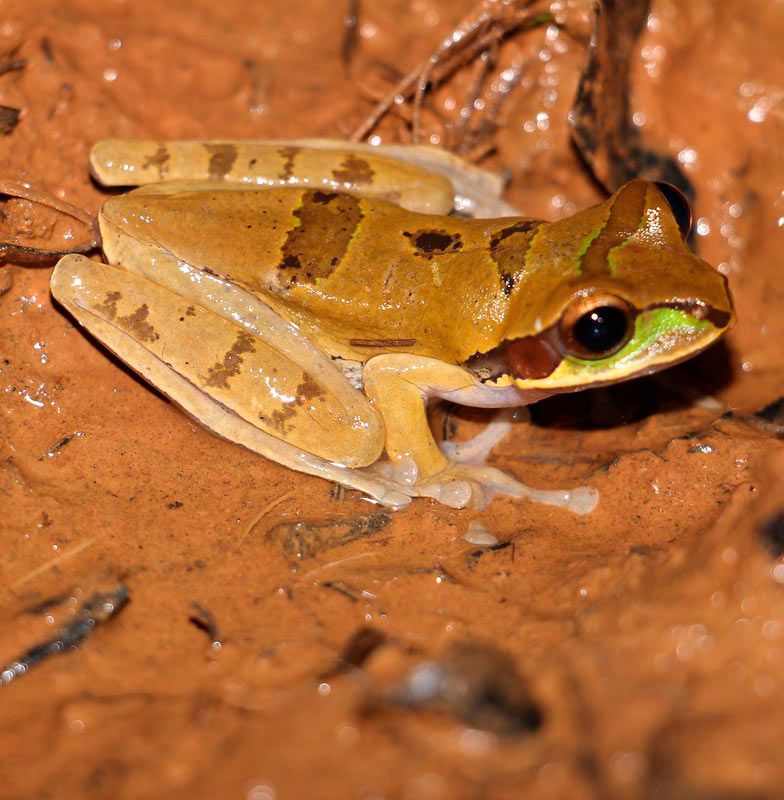
Name: Masked tree frog.
Scientific name: Smilisca phaeota.
Natural history: It is a species of frog in the Hylidae family. They are nocturnal frogs that can lay more than 1,000 eggs per litter.
The common tree frogs (Hylidae) are the most diverse family of anuran amphibians (with 718 species, outnumbering the next one, the jesters), being highly variable morphologically and ecologically.
Some are green, although there is great diversity in their pigmentation. They generally feed on insects, but some hunt small vertebrates. They are distributed throughout the areas of mild temperatures in America, Palearctic Eurasia and North Africa.
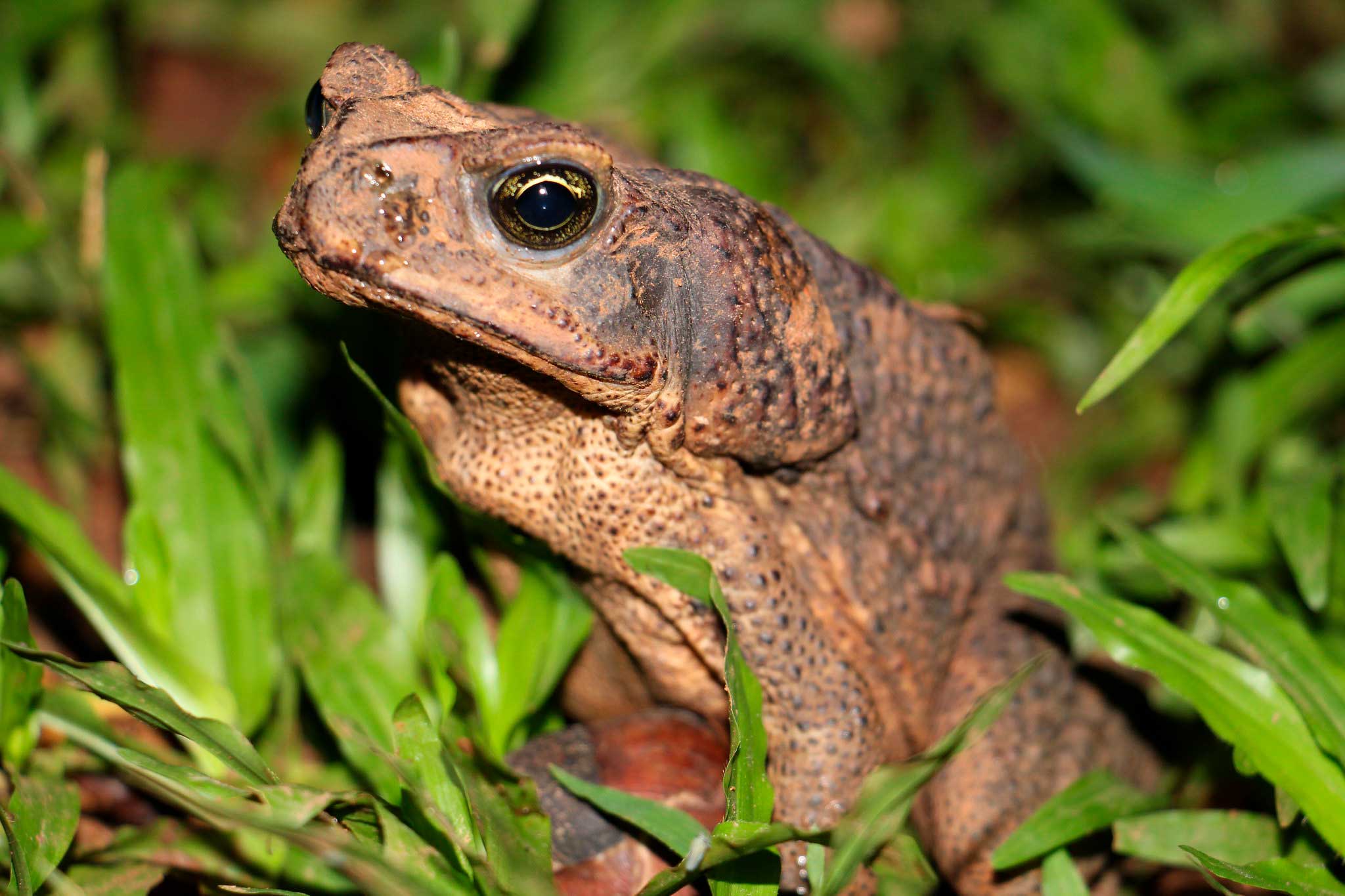
Name: Cane toad.
Scientific name: Rhinella marina.
Natural history: The giant toad or cane toad (Rhinella marina) also known as the giant neotropical toad or marine toad, is a species of the Bufonidae family. This amphibian has large poisonous glands; adults and tadpoles when ingested are highly toxic to most animals.
It is large and terrestrial, measuring an average of 10 to 15 cm; the largest specimen recorded weighed 2.65 kg and reached 38 cm from snout to cloaca and 54 cm fully extended. Dry and warty skin. It has distinct bumps that start above the eyes and end on the snout. It can be gray, brown, red-brown or olive.
The Cane Toad has a large paratoid gland behind each eye, cream colored belly and sometimes spots in shades of black or brown, horizontal pupils with golden irises, toes with fleshy membranes at their base, but the fingers are free.
This toad is a member of the genus Rhinella with dozens of species of toads in different habitats in America. It is included in the IUCN list of 100 most harmful invasive alien species in the world.
It derives its common name from its use against sugarcane pests but is now considered a pest in many of its introduced regions as the toxicity of its skin kills native predators when eaten.
It is a prolific breeder; females deposit a single group, spawning manyeggs. Their reproductive success is in part due to timely feeding; they have a diet, rare among anurans, of both, living and dead matter.